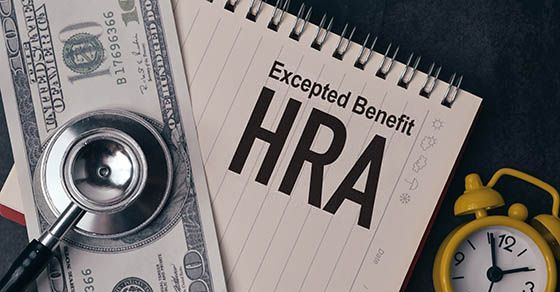Healthy savings: How tax-smart HSAs can benefit your small business and employees
December 2, 2024
As a small business owner, managing health care costs for yourself and your employees can be challenging. One effective tool to consider adding is a Health Savings Account (HSA). HSAs offer a range of benefits that can help you save on health care expenses while providing valuable tax advantages. You may already have an HSA. It’s a good time to review how these accounts work because the IRS has announced the relevant inflation-adjusted amounts for 2025.
HSA basics
For eligible individuals, HSAs offer a tax-advantaged way to set aside funds (or have their employers do so) to meet future medical needs. Employees can’t be enrolled in Medicare or claimed on someone else’s tax return.
Here are the key tax benefits:
• Contributions that participants make to an HSA are deductible, within limits.
• Contributions that employers make aren’t taxed to participants.
• Earnings on the funds within an HSA aren’t taxed so the money can accumulate tax-free year after year.
• HSA distributions to cover qualified medical expenses aren’t taxed.
• Employers don’t have to pay payroll taxes on HSA contributions made by employees through payroll deductions.
Key 2024 and 2025 amounts
To be eligible for an HSA, an individual must be covered by a “high-deductible health plan.” For 2024, a high-deductible health plan has an annual deductible of at least $1,600 for self-only coverage or at least $3,200 for family coverage. For 2025, these amounts are $1,650 and $3,300, respectively.
For self-only coverage, the 2024 limit on deductible contributions is $4,150. For family coverage, the 2024 limit on deductible contributions is $8,300. For 2025, these amounts are increasing to $4,300 and $8,550, respectively. Additionally, for 2024, annual out-of-pocket expenses for covered benefits can’t exceed $8,050 for self-only coverage or $16,100 for family coverage. For 2025, these amounts are increasing to $8,300 and $16,600.
An individual (and the individual’s covered spouse, as well) who has reached age 55 before the close of the tax year (and is an eligible HSA contributor) may make additional “catch-up” contributions for 2024 and 2025 of up to $1,000.
Making contributions for your employees
If an employer contributes to the HSA of an eligible individual, the employer’s contribution is treated as employer-provided coverage for medical expenses under an accident or health plan. It is excludable from an employee’s gross income up to the deduction limitation. There’s no “use-it-or-lose-it” provision, so funds can build for years. An employer that decides to make contributions on its employees’ behalf must generally make similar contributions to the HSAs of all comparable participating employees for that calendar year. If the employer doesn’t make similar contributions, the employer is subject to a 35% tax on the aggregate amount contributed by the employer to HSAs for that period.
Using funds to pay medical expenses
Your employees can take HSA distributions to pay for qualified medical expenses. This generally means expenses that would qualify for the medical expense itemized deduction. They include costs for doctors’ visits, prescriptions, chiropractic care and premiums for long-term care insurance.
The withdrawal is taxable if funds are withdrawn from the HSA for any other reason. Additionally, an extra 20% tax will apply to the withdrawal unless it’s made after age 65 or in the case of death or disability.
As you can see, HSAs offer a flexible option for providing health care coverage, but the rules are somewhat complex. Contact us with questions or if you’d like to discuss offering this benefit to your employees.
© 2024

Today’s companies have several kinds of tax-advantaged accounts or arrangements they can sponsor to help employees pay eligible medical expenses. One of them is a Health Reimbursement Arrangement (HRA). Under an HRA, your business sets up and wholly funds a plan that reimburses participants for qualified medical expenses of your choosing. (To be clear, employees can’t contribute.) The primary advantage is that plan design is very flexible, giving you greater control of your “total benefits spend.” Plus, your company’s contributions are tax deductible. How flexible are HRAs? They’re so flexible that businesses have multiple plan types to choose from. Let’s focus on one in particular: excepted benefit HRAs (EBHRAs). 4 key rules Although traditional HRAs integrated with group health insurance provide significant control, they’re still subject to mandates under the Public Health Service Act (PHSA), which was amended by the Affordable Care Act (ACA). This means you must deal with prohibitions on annual and lifetime limits for essential health benefits and requirements to provide certain preventive services without cost-sharing. Because employer contributions to EBHRAs are so limited, participants’ accounts under these plans qualify as “excepted benefits.” Therefore, these plans aren’t subject to the ACA’s PHSA mandates. Any size business may sponsor an EBHRA, but you must follow certain rules. Four of the most important are: 1. Contribution limits. In 2025, employer-sponsors may contribute up to $2,150 to each participant per plan year. You can, however, choose to contribute less. You can also decide whether to allow carryovers from year to year, which don’t count toward the annual limit. 2. Qualified reimbursements. An EBHRA may reimburse any qualified, out-of-pocket medical expense other than premiums for: Individual health coverage, Medicare, and Non-COBRA group coverage. Premiums for coverage consisting solely of excepted benefits can be reimbursed, as can premiums for short-term, limited-duration insurance (STLDI). However, under certain circumstances, federal agencies may prohibit small employer EBHRAs in some states from allowing STLDI premium reimbursement. (Contact your benefits advisor for further information.) 3. Required other coverage. Employer-sponsors must make other non-excepted, non-account-based group health plan coverage available to EBHRA participants for the plan year. Thus, you can’t also offer a traditional HRA. 4. Uniform availability. An EBHRA must be made available to all similarly situated individuals under the same terms and conditions, as defined and provided by applicable regulations. Additional compliance matters An EBHRA’s status as an excepted benefit means it’s not subject to the ACA’s PHSA mandates (as mentioned) or the portability and nondiscrimination rules of the Health Insurance Portability and Accountability Act (HIPAA). However, EBHRAs are subject to HIPAA’s administrative simplification requirements. This includes the law’s privacy and security rules unless an exception applies — such as for certain small self-insured, self-administered plans. In addition, like traditional HRAs integrated with group health insurance, EBHRAs sponsored by businesses are generally subject to the Employee Retirement Income Security Act (ERISA). This means: Reimbursement requests must comply with ERISA’s claim and appeal procedures, Participants must receive a summary plan description, and Other ERISA requirements may apply. Finally, EBHRAs must comply with ERISA’s nondiscrimination rules. These ensure that benefits provided under the plan don’t disproportionately favor highly compensated employees over non-highly compensated ones. Many factors to analyze As noted above, the EBHRA is only one type of plan your company can consider. Others include traditional HRAs integrated with group health insurance, qualified small employer HRAs and individual coverage HRAs. Choosing among them — or whether to sponsor an HRA at all — will call for analyzing factors such as what health benefits you already offer, which employees you want to cover, how much you’re able to contribute and which medical expenses you wish to reimburse. Let us help you evaluate all your benefit costs and develop a strategy for health coverage that makes the most sense for your business. © 2025

Suppose you’re thinking about setting up a retirement plan for yourself and your employees. However, you’re concerned about the financial commitment and administrative burdens involved. There are a couple of options to consider. Let’s take a look at a Simplified Employee Pension (SEP) and a Savings Incentive Match Plan for Employees (SIMPLE). SEPs offer easy implementation SEPs are intended to be an attractive alternative to “qualified” retirement plans, particularly for small businesses. The appealing features include the relative ease of administration and the discretion that you, as the employer, are permitted in deciding whether or not to make annual contributions. If you don’t already have a qualified retirement plan, you can set up a SEP just by using the IRS model SEP, Form 5305-SEP. By adopting and implementing this model SEP, which doesn’t have to be filed with the IRS, you’ll have satisfied the SEP requirements. This means that as the employer, you’ll get a current income tax deduction for contributions you make on your employees’ behalf. Your employees won’t be taxed when the contributions are made but will be taxed later when distributions are received, usually at retirement. Depending on your needs, an individually-designed SEP — instead of the model SEP — may be appropriate for you. When you set up a SEP for yourself and your employees, you’ll make deductible contributions to each employee’s IRA, called a SEP-IRA, which must be IRS approved. The maximum amount of deductible contributions you can make to an employee’s SEP-IRA in 2025, and that he or she can exclude from income, is the lesser of 25% of compensation or $70,000. The deduction for your contributions to employees’ SEP-IRAs isn’t limited by the deduction ceiling applicable to an individual’s contributions to a regular IRA. Your employees control their individual IRAs and IRA investments, the earnings on which are tax-free. You’ll have to meet other requirements to be eligible to set up a SEP. Essentially, all regular employees must elect to participate in the program, and contributions can’t discriminate in favor of highly compensated employees. But these requirements are minor compared to the bookkeeping and other administrative burdens associated with traditional qualified pension and profit-sharing plans. The detailed records that traditional plans must maintain to comply with the complex nondiscrimination rules aren’t required for SEPs. And employers aren’t required to file annual reports with the IRS, which, for a pension plan, could require the services of an actuary. The required recordkeeping can be done by a trustee of the SEP-IRAs — usually a bank or mutual fund. SIMPLE plans meet IRS requirements Another option for a business with 100 or fewer employees is a Savings Incentive Match Plan for Employees (SIMPLE). Under these plans, a SIMPLE IRA is established for each eligible employee, with the employer making matching contributions based on contributions elected by participating employees under a qualified salary reduction arrangement. The SIMPLE plan is also subject to much less stringent requirements than traditional qualified retirement plans. Or, an employer can adopt a SIMPLE 401(k) plan, with similar features to a SIMPLE IRA plan, and avoid the otherwise complex nondiscrimination test for traditional 401(k) plans. For 2025, SIMPLE deferrals are allowed for up to $16,500 plus an additional $3,500 catch-up contribution for employees age 50 or older. Unique advantages As you can see, SEP and SIMPLE plans offer unique advantages for small business owners and their employees. Neither plan requires annual filings with the IRS. Contact us for more information or to discuss any other aspect of your retirement planning. © 2025

If you’re considering making asset transfers to your grandchildren or great grandchildren, be sure your estate plan addresses the federal generation-skipping transfer (GST) tax. This tax ensures that large estates can’t bypass a round of taxation that would normally apply if assets were transferred from parent to child, and then from child to grandchild. Because of the complexity and potential tax liability, careful estate planning is essential when considering generation-skipping transfers. Trusts are often used as a strategic vehicle to allocate the GST tax exemption amount effectively and ensure that assets pass tax-efficiently to younger generations. ABCs of the GST tax The GST tax applies at a flat 40% rate — in addition to otherwise applicable gift and estate taxes — to transfers that skip a generation. “Skip persons” include your grandchildren, other relatives who are more than one generation below you and unrelated people who are more than 37½ years younger than you. There’s an exception, however, for a grandchild whose parent (your child) predeceases you. In that case, the grandchild moves up a generation and is no longer considered a skip person. Even though the GST tax enjoys an annual inflation-adjusted lifetime exemption in the same amount as the lifetime gift and estate tax exemption (currently, $13.99 million), it works a bit differently. For example, while the gift and estate tax exemption automatically protects eligible transfers of wealth, the GST tax exemption must be allocated to a transfer to shelter it from tax. 3 transfer types trigger GST tax There are three types of transfers that may trigger the GST tax: A direct skip — a transfer directly to a skip person that is subject to federal gift and estate tax, A taxable distribution — a distribution from a trust to a skip person, or A taxable termination — such as when you establish a trust for your children, the last child beneficiary dies and the trust assets pass to your grandchildren. The GST tax doesn’t apply to transfers to which you allocate your GST tax exemption. In addition, the GST tax annual exclusion — which is similar to the gift tax annual exclusion — allows you to transfer up to $19,000 per year (for 2025) to any number of skip persons without triggering GST tax or using up any of your GST tax exemption. Transfers to a trust qualify for the annual GST tax exclusion only if the trust 1) is established for a single beneficiary who’s a grandchild or other skip person, and 2) provides that no portion of its income or principal may be distributed to (or for the benefit of) anyone other than that beneficiary. Additionally, if the trust doesn’t terminate before the beneficiary dies, any remaining assets will be included in the beneficiary’s gross estate. If you wish to make substantial gifts, either outright or in trust, to your grandchildren or other skip persons, allocate your GST tax exemption carefully. Turn to us for answers regarding the GST tax. © 2025

At first glance, the word “concentration” might seem to describe a positive quality for any business owner. You need to concentrate, right? Only through laser focus on the right strategic goals can your company reach that next level of success. In a business context, however, concentration can refer to various aspects of your company’s operations. And examining different types of it may help you spot certain dangers. Evaluate your customers Let’s start with customer concentration, which is the percentage of revenue generated from each customer. Many small to midsize companies rely on only a few customers to generate most of their revenue. This is a precarious position to be in. The dilemma is more prevalent in some industries than others. For example, a retail business will likely market itself to a relatively broad market and generally not face too much risk related to customer concentration. A commercial construction company, however, may serve only a limited number of clients that build, renovate or maintain offices or other facilities. How do you know whether you’re at risk? One rule of thumb says that if your biggest five customers make up 25% or more of your revenue, your customer concentration is generally high. Another simple measure says that, if any one customer represents 10% or more of revenue, you’re at risk of having elevated customer concentration. In an increasingly specialized world, many businesses focus solely on specific market segments. If yours is one of them, you may not be able to do much about customer concentration. In fact, the very strength of your company could be its knowledge and attentiveness to a limited number of buyers. Nonetheless, know your risk and explore strategic planning concepts that may help you mitigate it. If diversifying your customer base isn’t an option, be sure to maintain the highest level of service. Look at other areas There are other types of concentration. For instance, vendor concentration refers to the number and types of vendors a company uses to support its operations. Relying on too few vendors is risky. If any one of them goes out of business or substantially raises prices, the company could suffer a severe rise in expenses or even find itself unable to operate. Your business may also be affected by geographic concentration. This is how a physical location affects your operations. For instance, if your customer base is concentrated in one area, a dip in the regional economy or the arrival of a disruptive competitor could negatively impact profitability. Small local businesses are, by definition, subject to geographic concentration. However, they can still monitor the risk and explore ways to mitigate it — such as through online sales in the case of retail businesses. You can also look at geographic concentration globally. Say your company relies solely or largely on a specific foreign supplier for iron, steel or other materials. That’s a risk. Tariffs, which have been in the news extensively this year, can significantly impact your costs. Geopolitical and environmental factors might also come into play. Third, stay cognizant of your investment concentration. This is how you allocate funds toward capital improvements, such as better facilities, machinery, equipment, technology and talent. The term can also refer to how your company manages its investment portfolio, if it has one. Regularly reevaluate risk tolerance and balance. For instance, are you overinvesting in technology while underinvesting in hiring or training? Study your company As you can see, concentration takes many different forms. This may explain why business owners often get caught off guard by the sudden realization that their companies are over- or under-concentrated in a given area. We can help you perform a comprehensive risk assessment that includes, among other things, developing detailed financial reports highlighting areas of concentration. © 2025

Once your 2024 tax return is in the hands of the IRS, you may be tempted to clear out file cabinets and delete digital folders. But before reaching for the shredder or delete button, remember that some paperwork still has two important purposes: Protecting you if the IRS comes calling for an audit, and Helping you prove the tax basis of assets you’ll sell in the future. Keep the return itself — indefinitely Your filed tax returns are the cornerstone of your records. But what about supporting records such as receipts and canceled checks? In general, except in cases of fraud or substantial understatement of income, the IRS can only assess tax within three years after the return for that year was filed (or three years after the return was due). For example, if you filed your 2022 tax return by its original due date of April 18, 2023, the IRS has until April 18, 2026, to assess a tax deficiency against you. If you file late, the IRS generally has three years from the date you filed. In addition to receipts and canceled checks, you should keep records, including credit card statements, W-2s, 1099s, charitable giving receipts and medical expense documentation, until the three-year window closes. However, the assessment period is extended to six years if more than 25% of gross income is omitted from a return. In addition, if no return is filed, the IRS can assess tax any time. If the IRS claims you never filed a return for a particular year, a copy of the signed return will help prove you did. Property-related and investment records The tax consequences of a transaction that occurs this year may depend on events that happened years or even decades ago. For example, suppose you bought your home in 2009, made capital improvements in 2016 and sold it this year. To determine the tax consequences of the sale, you must know your basis in the home — your original cost, plus later capital improvements. If you’re audited, you may have to produce records related to the purchase in 2009 and the capital improvements in 2016 to prove what your basis is. Therefore, those records should be kept until at least six years after filing your return for the year of sale. Retain all records related to home purchases and improvements even if you expect your gain to be covered by the home-sale exclusion, which can be up to $500,000 for joint return filers. You’ll still need to prove the amount of your basis if the IRS inquires. Plus, there’s no telling what the home will be worth when it’s sold, and there’s no guarantee the home-sale exclusion will still be available in the future. Other considerations apply to property that’s likely to be bought and sold — for example, stock or shares in a mutual fund. Remember that if you reinvest dividends to buy additional shares, each reinvestment is a separate purchase. Duplicate records in a divorce or separation If you separate or divorce, be sure you have access to tax records affecting you that your spouse keeps. Or better yet, make copies of the records since access to them may be difficult. Copies of all joint returns filed and supporting records are important because both spouses are liable for tax on a joint return, and a deficiency may be asserted against either spouse. Other important records to retain include agreements or decrees over custody of children and any agreement about who is entitled to claim them as dependents. Protect your records from loss To safeguard records against theft, fire or another disaster, consider keeping essential papers in a safe deposit box or other safe place outside your home. In addition, consider keeping copies in a single, easily accessible location so that you can grab them if you must leave your home in an emergency. You can also scan or photograph documents and keep encrypted copies in secure cloud storage so you can retrieve them quickly if they’re needed. We’re here to help Contact us if you have any questions about record retention. Thoughtful recordkeeping today can save you time, stress and money tomorrow. © 2025

With summer fast approaching, you might be considering hiring young people at your small business. If your children are also looking to earn some extra money, why not put them on the payroll? This move can help you save on family income and payroll taxes, making it a win-win situation for everyone! Here are three tax benefits. 1. You can transfer business earnings Turn some of your high-taxed income into tax-free or low-taxed income by shifting some business earnings to a child as wages for services performed. For your business to deduct the wages as a business expense, the work done by the child must be legitimate. In addition, the child’s salary must be reasonable. (Keep detailed records to substantiate the hours worked and the duties performed.) For example, suppose you’re a sole proprietor in the 37% tax bracket. You hire your 17-year-old daughter to help with office work full-time in the summer and part-time in the fall. She earns $10,000 during the year (and doesn’t have other earnings). You can save $3,700 (37% of $10,000) in income taxes at no tax cost to your daughter, who can use her $15,000 standard deduction for 2025 (for single filers) to shelter her earnings. Family taxes are cut even if your daughter’s earnings exceed her standard deduction. That’s because the unsheltered earnings will be taxed to her beginning at a 10% rate, instead of being taxed at your higher rate. 2. You may be able to save Social Security tax If your business isn’t incorporated, you can also save some Social Security tax by shifting some of your earnings to your child. That’s because services performed by a child under age 18 while employed by a parent aren’t considered employment for FICA tax purposes. A similar but more liberal exemption applies for FUTA (unemployment) tax, which exempts earnings paid to a child under age 21 employed by a parent. The FICA and FUTA exemptions also apply if a child is employed by a partnership consisting only of his or her parents. Note: There’s no FICA or FUTA exemption for employing a child if your business is incorporated or is a partnership that includes non-parent partners. However, there’s no extra cost to your business if you’re paying a child for work you’d pay someone else to do. 3. Your child can save in a retirement account Your business also may be able to provide your child with retirement savings, depending on your plan and how it defines qualifying employees. For example, if you have a SEP plan, a contribution can be made for up to 25% of your child’s earnings (not to exceed $70,000 for 2025). Your child can also contribute some or all of his or her wages to a traditional or Roth IRA. For the 2025 tax year, your child can contribute the lesser of: His or her earned income, or $7,000. Keep in mind that traditional IRA withdrawals taken before age 59½ may be hit with a 10% early withdrawal penalty tax unless an exception applies. (Several exceptions exist, including to pay for qualified higher-education expenses and up to $10,000 in qualified first-time homebuyer costs.) Tax benefits and more In addition to the tax breaks from hiring your child, there are nontax benefits. Your son or daughter will better understand your business, earn extra spending money and learn responsibility. Contact us if you have any questions about the tax rules in your situation. Keep in mind that some of the rules about employing children may change from year to year and may require your income-shifting strategies to change too. © 2025

President Trump’s “Liberation Day” announcement of global tariffs caught businesses, as well as foreign countries and worldwide financial markets, off guard. While the president has long endorsed the imposition of tariffs, many businesses expected him to take a targeted approach. Instead, Trump rolled out a baseline tariff on all imports to the United States and higher tariffs on certain countries, including some of the largest U.S. trading partners. (On April 9, Trump announced a 90-day pause on some reciprocal tariffs, with a 10% baseline tariff remaining in effect for most countries and a 145% tariff on imports from China.) The tariff plan sent businesses, both large and small, scrambling. Even companies accustomed to dealing with tariffs have been shaken because this round is so much more extensive and seemingly subject to change than those in the past. Proponents of tariffs say they can be used as a negotiating tool to get other countries to lower their tariffs on U.S. imports, thereby leveling the global trade playing field. They also argue that if domestic and foreign companies relocate to the United States, it’ll create jobs for Americans, fuel construction industry growth and provide additional tax revenue. Since more changes are expected as countries and industries negotiate with the administration for reduced rates and exemptions, some degree of uncertainty is likely to prevail for at least the short term. In the meantime, businesses have several areas they should focus on to reduce the tariff hit to their bottom lines. 1. Financial forecasting No business should decide how to address tariff repercussions until they’ve conducted a comprehensive financial analysis to understand how U.S. and retaliatory tariffs will affect costs. You might find, for example, that your business needs to postpone impending plans for capital asset purchases or expansion. Modeling, or scenario planning, is often helpful during unpredictable periods. Begin by identifying all the countries involved in your supply chain, whether you deal with them directly or through your suppliers, and the applicable tariffs, whether you’re importing or exporting goods. You can then develop a model that projects how different sourcing scenarios might play out. The model should compare not only the costs of foreign vs. domestic options but also the resulting impact on your pricing, labor costs, cash flow and, ultimately, profitability. This information can allow you to build contingency plans to help reduce the odds of being caught flat-footed as new developments unfurl. Modeling can provide valuable guidance if you’re considering reshoring your operations. Of course, reshoring isn’t a small endeavor. Moreover, U.S. infrastructure may not be adequate for your business needs. Manufacturers also should note the shortage of domestic manufacturing workers. According to pre-tariff analysis from the National Association of Manufacturers, the U.S. manufacturing industry could require some 3.8 million jobs by 2033, and more than 1.9 million may go unfilled. 2. Pricing Perhaps the most obvious tactic for companies incurring higher costs due to tariffs is to pass the increases along to their customers. It’s not that simple, though. Before you raise your prices, you must take into account factors such as your competitors’ pricing and how higher prices might affect demand. The latter is especially critical for price-sensitive consumer goods where even a small price jump could undermine demand. Consumers have already been cutting back on spending based on rising fears of inflation and a possible recession. Price increases, therefore, are better thought of as a single component in a more balanced approach. 3. Foreign Trade Zones You may be able to take advantage of Foreign Trade Zones (FTZs) to minimize your tariff exposure. In these designated areas near U.S. ports of entry, a company can move goods in and out of the country for operations (including assembly, manufacturing and processing) but pay reduced or no tariffs. Tariffs are paid when the goods are transferred from an FTZ into the United States for consumption. While in the zone, though, goods aren’t subject to tariffs. And, if the goods are exported, no tariff applies. Note: Trump already has narrowed some of the potential benefits of FTZs, so avoid making them a cornerstone of your tariff strategy. 4. Internal operations If your company’s suppliers are in high-tariff countries, you can look into switching to lower-cost suppliers in countries that have negotiated lower tariffs. You may not be able to escape higher costs stemming from tariffs, but you can take steps to cut other costs by streamlining operations. For example, you could invest in technologies to improve efficiency or trim worker hours and employee benefits. You also should try to renegotiate contracts with suppliers and vendors, even if those relationships aren’t affected by tariffs. Such measures might make it less necessary to hike your prices. You can control your overall costs as well by breaking down departmental silos so the logistics or procurement department isn’t making tariff-related decisions without input from others. Your finance and tax departments need to weigh in to achieve the optimal cost structures. 5. Tax planning Maximizing your federal and state tax credits is paramount in financially challenging times. Technology investments, for example, may qualify for Section 179 expensing and bonus depreciation (which may return to 100% in the first year under the upcoming tax package being negotiated in Congress). Certain sectors may benefit from the Sec. 45X Advanced Manufacturing Production Credit or the Sec. 48D Advanced Manufacturing Investment Credit. Several states also offer tax credits for job creation, among other tax incentives. This may be a wise time to consider changing your inventory accounting method, if possible. The last-in, first-out (LIFO) method assumes that you use your most recently purchased materials first. The cost of the newer, pricier items is charged first to the cost of goods sold, boosting it and cutting both your income and taxes. Bear in mind, though, that LIFO isn’t permitted under the International Financial Reporting Standards and is more burdensome than the first-in, first-out method. 6. Compliance Regardless of the exact percentages of U.S. and retaliatory tariffs, you can count on tighter scrutiny of your compliance with the associated rules and requirements. These probably will become more complicated than they’ve been in the past. For example, expect greater documentation requirements and shifting rules for identifying an item’s country of origin. The higher compliance burden alone will ramp up your costs — but the costs of noncompliance could be far greater. Stay vigilant The tariff landscape is rapidly evolving. You need to monitor the actions by the Trump administration, the responses of other countries and how they affect your business operations. You may have to pivot as needed to keep costs low (by reshoring or switching to suppliers in low-tariff countries). If you don’t have the requisite financial expertise on staff to keep up with it all, we can help. Contact us today about how to plan ahead — and stay ahead of the changes. © 2025

“Decanting” an irrevocable trust allows a trustee to use his or her distribution powers to transfer assets from one trust into another with different — often more favorable — terms. Much like decanting wine to separate it from sediment, trust decanting “pours” assets into a new vessel, potentially improving clarity and control. While the original trust must be irrevocable, meaning its terms typically can’t be changed by the grantor, decanting offers a lawful method for trustees to update or adjust those terms under certain conditions. Decanting Q&As There are several reasons a trustee might consider decanting. For example, the original trust may lack flexibility to deal with changing tax laws, family circumstances or beneficiary needs. Decanting can allow for the removal of outdated provisions, the addition of modern administrative powers or even a change in the trust’s governing law to a more favorable jurisdiction. It may also provide a way to correct drafting errors, protect assets from creditors or introduce special needs provisions for a beneficiary who becomes disabled. However, decanting laws vary dramatically from state to state, so it’s important to familiarize yourself with your state’s rules and evaluate their effect on your estate planning goals. Here are several common questions and answers regarding decanting a trust: Q: If your trust is in a state without a decanting law, can you benefit from another state’s law? A: Generally yes, but to avoid any potential complaints by beneficiaries it’s a good idea to move the trust to a state whose law specifically addresses this issue. In some cases, it’s simply a matter of transferring the existing trust’s governing jurisdiction to the new state or arranging for it to be administered in that state. Q: Does the trustee need to notify beneficiaries or obtain their consent? A: Decanting laws generally don’t require beneficiaries to consent to a trust decanting and several states don’t even require that beneficiaries be notified. Where notice is required, the specific requirements are all over the map: Some states require notice to current beneficiaries while others also include contingent or remainder beneficiaries. Even if notice isn’t required, notifying beneficiaries may help stave off potential disputes in the future. Q: What is the trustee’s authority? A: When exploring decanting options, trustees should consider which states offer them the greatest flexibility to achieve their goals. In general, decanting authority is derived from a trustee’s power to make discretionary distributions. In other words, if the trustee is empowered to distribute the trust’s funds among the beneficiaries, he or she should also have the power to distribute them to another trust. But state decanting laws may restrict this power. Decanting can be complicated Because of its complexity, decanting an irrevocable trust should be approached with careful legal and tax guidance. When used appropriately, it can be a strategic way to modernize an inflexible trust and better serve your long-term goals as well as your beneficiaries. Consult with us before taking action. © 2025

Small to midsize businesses have valid reasons for incorporating, not the least of which is putting that cool “Inc.” at the end of their names. Other reasons include separating owners’ personal assets from their business liabilities and offering stock options as an employee incentive. If you’re considering incorporation for your company, however, it’s essential to be aware of the associated risks. One of them is the reasonable compensation conundrum. How much is too much? Let’s say you decide to convert your business to a C corporation. After completing the incorporation process, you can pay owners, executives and other highly compensated employees some combination of compensation and dividends. More than likely, you’ll want to pay your highly compensated employees more in compensation and less in dividends because compensation is tax deductible and dividends aren’t. But be careful — the IRS may be watching. If it believes you’re excessively compensating a highly compensated employee for tax avoidance purposes, it may challenge your compensation approach. Such challenges typically begin with an audit and may result in the IRS being allowed to reclassify compensation as dividends — with penalties and interest potentially tacked on. What’s worse, if the tax agency succeeds with its challenge, the difference between what you paid a highly compensated employee and what the tax agency considers a reasonable amount for the services rendered usually isn’t deductible. Of course, you can contest an IRS challenge. However, doing so usually involves considerable legal expenses and time — and a positive outcome is far from guaranteed. Note: S corporations are a different story. Under this entity type, income and losses usually “pass through” to business owners at the individual level and aren’t subject to payroll tax. Thus, S corporation owners usually prefer to receive distributions. As a result, the IRS may raise a reasonable compensation challenge when it believes a company’s owners receive too little salary. What are the factors? There’s no definitive bright-line test for determining reasonable compensation. However, over the years, courts have considered various factors, including: The nature, extent and scope of an employee’s work, The employee’s qualifications and experience, The size and complexity of the business, A comparison of salaries paid to the sales, gross income and net worth of the business, General economic conditions, The company’s financial status, The business’s salary policy for all employees, Salaries of similar positions at comparable companies, and Historical compensation of the position. It’s also important to assess whether the business and employee are dealing at an “arm’s length,” and whether the employee has guaranteed the company’s debts. Can you give me an example? Just a few years ago, a case played out in the U.S. Tax Court illustrating the risks of an IRS challenge regarding reasonable compensation. The owner of a construction business structured as a C corporation led his company through tough times and turned it into a profitable enterprise. When the business recorded large profits in 2015 and 2016, primarily because of the owner’s personal efforts and contacts, it paid him a bonus of $5 million each year in addition to his six-figure salary. The IRS claimed this was excessive. The Tax Court relied heavily on expert witnesses to make its determination. Ultimately, it decided against the business, finding that reasonable amounts for the bonuses were $1.36 million in 2015 and $3.68 million in 2016, respectively. (TC Memo 2022-15) Who can help? As your business grows, incorporation may help your company guard against certain risks and achieve a greater sense of stature. However, there are tax complexities to consider. If you’re thinking about it, please contact us for help identifying the advantages and risks from both tax and strategic perspectives. © 2025

